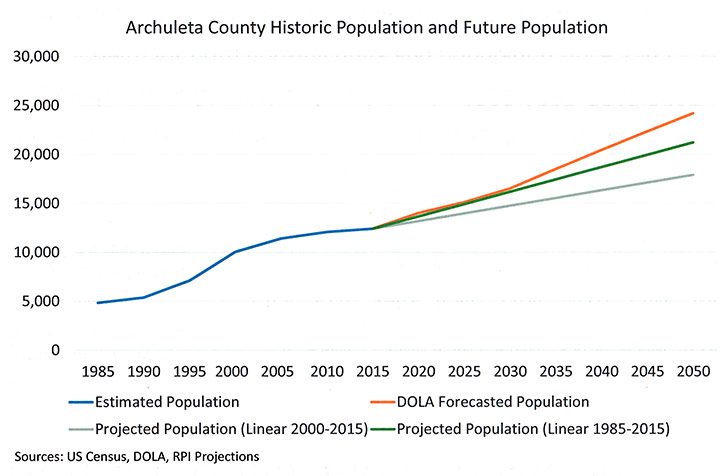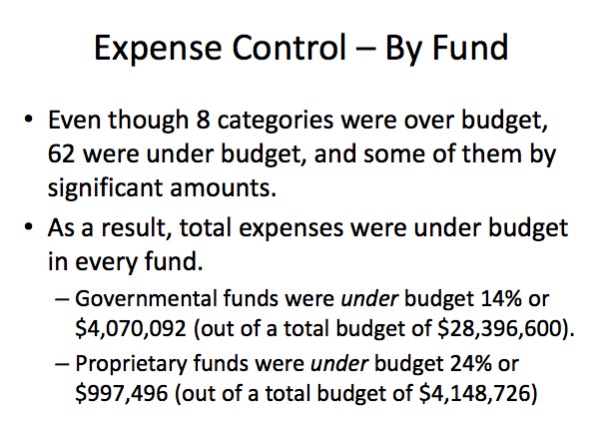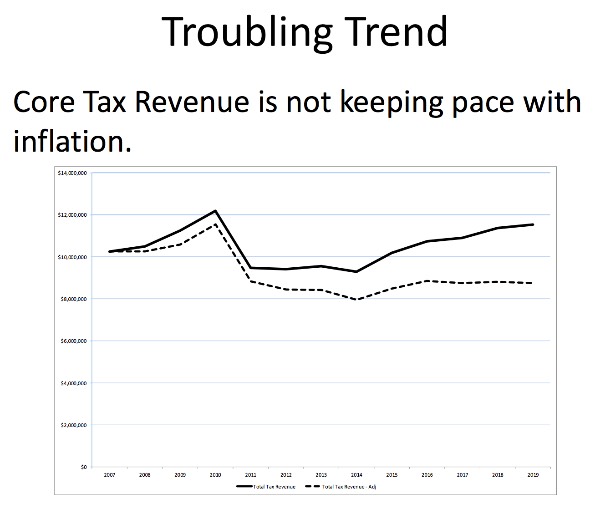Expenses were either kept under control, or (mostly) covered by unanticipated revenue adjustments. The last few years have gone well… therefore, we are concerned about the future…
— from the Archuleta County Fourth Quarter Financial Report, delivered by Finance Director Larry Walton, March 19, 2019
“The last few years have gone well…”
Therefore, we are concerned about the future. Because we’re pretty sure things are not going to improve.
I don’t always agree with Archuleta County Finance Director Larry Walton, but it does happen on occasion. In this particular case, we have to agree that certain things “have gone well” — which is to say, the County government has not gone bankrupt — while other things are going rather badly — especially, for many of the younger families in Pagosa Springs.
The economic past informs the economic future, or so it often seems. There’s a considerable amount of repetitious inertia in the patterns of human behavior, and one of the things that delights us most is when the future unfolds in an unexpected way. We humans love an element of surprise.
On the one hand, we want to see things to play out exactly the way we expected them to play out, based on what happened last year and the year before. At the same time, we don’t want life to be monotonous and mundane, so when unexpected changes occur, we can find ourselves excited, turned on, stimulated. So long as the surprises aren’t too painful.
I experienced surprise, for a brief moment, at the Archuleta Board of County Commissioners meeting on March 19, during Finance Director Larry Walton’s Fourth Quarter Financial Report — a report which doubled as the Year End 2018 Financial Report. One is easily tempted by government financial reports to log in to one’s Facebook account and see it anything interesting is happening. And some folks in the audience may have given in to that temptation. But curiosity got the best of me, and I watched the whole slideshow.
At first, it sounded like Mr. Walton was giving us only the good news about the County’s financial condition. We’ve heard ‘good news’ about County spending from Mr. Walton over the past several years. Tax revenues have a slight upward trend. County departments are generally behaving frugally, and spending less than their budgeted allotments.
According to this Powerpoint slide, the County’s various departments, collectively, spent $5 million less than what the BOCC had allotted them in the $32-million 2018 budget. As it turned out, much of the reported savings were purposely “built into the budget” in the form of “contingency items” — monies included in the budget to cover possible emergencies. Emergencies that, luckily, didn’t happen in 2018.
The County also failed to spend allotted amounts for several projects that were postponed, or this or that reason, until 2019 or later. So, those weren’t really savings — just delays in spending.
But overall, the picture Mr. Walton seemed to be painting on March 19 was a sunny one. A County doing pretty well, financially.
Larry Walton:
“The bad news is, the 2017 audit is late, and in complete at this time. It was delayed at the request of the investigators, related to the 1033 issue. That matter is ongoing, and as soon as I have a date for when it will be completed, I will share that with you.”
You can read about the 1033 issue in this Daily Post article.
That wasn’t the only bad news, however. Mr. Walton brought up the following Powerpoint slide.
The solid line here, Mr. Walton explained, was the actual dollar amount for County sales and property tax revenues, from 2007 projected through 2019. Because of a delay in the way property values are calculated, the drop in property tax collections in Archuleta County — caused by the Great Recession — didn’t hit the County books until 2011. Then tax collections stayed low until 2015, when the new Walmart store opened its doors and we saw an increase in sales tax.
As Mr. Walton noted, the dollar amount of County taxes collected in 2019 might be almost as much as the previous $12 million peak in 2010. (Assuming no surprises.)
“In raw dollar terms, that’s actually the case. But the dotted line beneath [the raw dollar amount] is what you see if you take the Consumer Price Index and apply it to the revenue that we have, and express everything in 2007 dollars. Purchasing power.”
“So in a sense, that dotted line is the current purchasing power of the taxes the County is receiving. We still see a huge increase in 2010. The Recession certainly did hurt us, more than otherwise might have been apparent. And after some recovery in 2015 and 2016, we’ve kind of plateaued at a very low level, relative to where we were in 2010.
“That’s worrisome, because we have a large number of capital projects before us. Not just the jail, but also the Courthouse, DHS, the Sheriff’s Office. A bunch of things are looming in the coming years. And this is something that affects us, very much, when coming up with the money to do those projects.”
Things look like they are going pretty well, on the surface. But maybe we actually have a crisis on the horizon?
Let’s stop here and analyze the bad news. The bad news that Mr. Walton, perhaps unknowingly, tucked in between the lines.
Yes, every capital project proposed by our local governments has been hit by inflation, as the dollar slowly loses its value here in America. Basically, there is no way that we can build all the new offices and jails and courthouses that our elected leaders want to build.
The reason the elected leaders want to build these shiny new facilities, is because they have failed to maintain our existing public facilities — and because our elected leaders feel a sense of entitlement. A sense that they should be able to let older buildings fall apart, and then demand that we — the taxpayers — fork out the money for new.
Listen, once again, to Mr. Walton.
“That’s worrisome, because we have a large number of capital projects before us. Not just the jail, but also the Courthouse, DHS, the Sheriff’s Office. A bunch of things are looming in the coming years. And this is something that affects us, very much, when coming up with the money to do those projects.”
The jail. Courtrooms and court offices. DHS offices. Sheriff’s offices. Capital projects that directly serve The County Government itself.
Where are the capital projects that directly serve The Taxpayers? Like, the County Roads, for example? Affordable Housing, for example? Not on Mr. Walton’s list, apparently.
As I look into the future, I see a fork in the road ahead, for the County. Yes, the population of Archuleta County might continue to increase. That’s very probable.

But one fork leads to failing, poorly-maintained infrastructure, and huge capital investments into new County facilities, funded by ever-growing government debt — and fueled by the belief that our children and grandchildren will eventually be able to pay off those debts.
The other fork leads to a growing understanding, among our community leaders, that we simply can’t afford “a large number of capital projects before us,” and that we must — we must — learn to live within our means. That we must learn to take care of what we already have.



